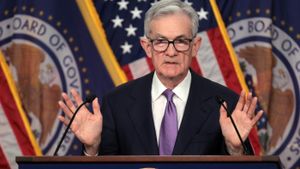Election Day is always a significant event, but this year it carried heightened stakes and concerns about safety and security. Across the country, voters encountered various challenges, from technical glitches to apparent threats, all of which underscored the importance of vigilance on this pivotal day.
One particularly alarming incident unfolded at the U.S. Capitol, where Austin M. Olson, a 27-year-old man from Michigan, was arrested after trying to enter the Capitol Visitor Center with suspicious items. U.S. Capitol Police apprehended Olson during security screening, where officers noticed items including a flare gun and torch lighter in his belongings. According to reports, Olson's jacket and bag triggered the screening machine, leading to a thorough search.
During the subsequent investigation, authorities discovered more than just weapons; they found a manifesto and letters discussing various issues, including conflicts overseas. Police described Olson as smelling strongly of fuel, raising serious concerns about his intentions. Capitol Police Chief J. Thomas Manger acknowledged the gravity of the situation by stating, "If our officers did not stop this man, yesterday would have been a very different story." This incident prompted officials to lock down the Capitol Visitor Center and suspend tours for the day.
The climate of fear surrounding Election Day security has become more pronounced. This was reflected not only at the Capitol but also at polling stations across cities such as New York. Voters there reported technical issues with voting machines, which led to ballots being rejected. Vinnie Ignizio, deputy executive director of the Board of Elections, assured residents every vote cast would be counted, regardless of the machine malfunctions. He also indicated technicians were deployed to rectify issues at various polling sites.
Yet the day wasn't solely marked by technology failures. Concerns about violence against election workers had prompted increased security measures throughout New York City. A staggering number of threats—over 2,000 nationally—highlighted the need for vigilance. Each polling station was guarded by two NYPD officers, reflecting the city’s commitment to preventing any potential disturbances. Jackie Bray, commissioner of the New York State Department of Homeland Security and Emergency Services, expressed confidence, stating, "I really feel confident we're not going to see violence at our polls."
Although many voters encountered setbacks, the Board of Elections emphasized its dedication to ensuring the integrity of the voting process, affirming no significant threats had emerged against election workers or voters.
Down south, election security preparations reached another level. The Pennsylvania State Police worked alongside the Pennsylvania Army National Guard, holding training sessions focusing on riot control and civil disturbance management to prepare for any potential unrest following the election results. Historical events, such as the January 6 insurrection at the Capitol, left lasting marks on law enforcement strategies, driving home the necessity for preparedness.
Concerns lingered about potential violence, fueled by recent history, including the foiled assassination attempt on former President Donald Trump. Officials recognized the potential for heightened tension stemming from divisive politics. According to reports, many Pennsylvanians—four out of ten—voiced serious fears of violence surrounding the election results.
Meanwhile, Arizona also faced its share of challenges. During Election Day, Scripps News reported firsthand from within the Maricopa County Sheriff's command center as they dealt with bomb threats directed at polling locations. These threats, part of various incidents nationwide, were linked to foreign actors, likely intended to disrupt the electoral process. Even so, election officials remained resolute, stating there was no credible danger.
While officials assured voters of safety and the integrity of the electoral process, the day also revealed the difficulties faced by those tasked with maintaining order. With heightened tensions surfacing across various states and many voters encountering technological issues, Election Day transformed from merely a day of civic duty to one of astute awareness and readiness.
Across these incidents, the focus remained clear: ensuring the safety and security of voters and election workers was priority number one. With many states gearing up for potential unrest as results rolled out, the stakes have never been higher. Regardless of the challenges faced on Election Day, the commitment of officials at all levels to safeguard democracy remained steadfast.



